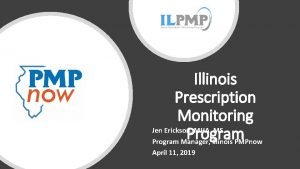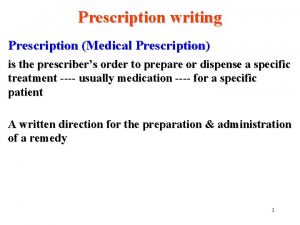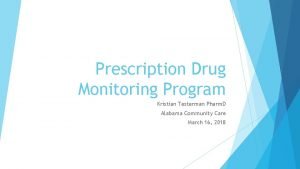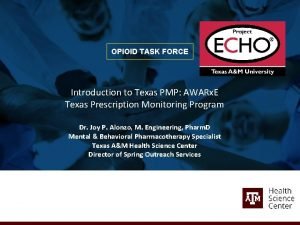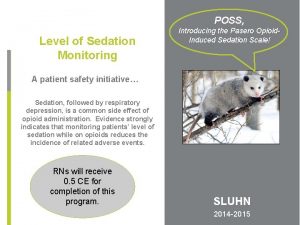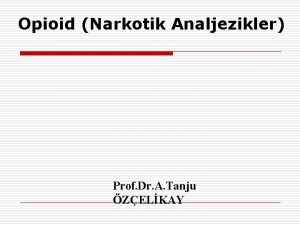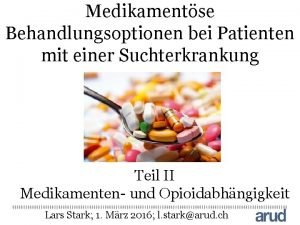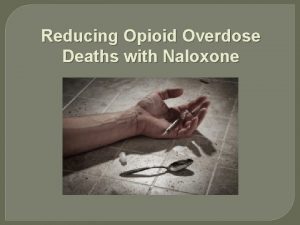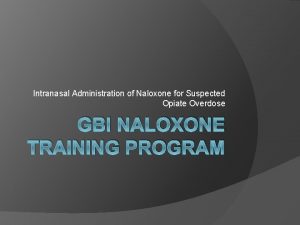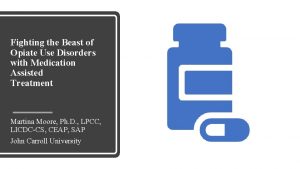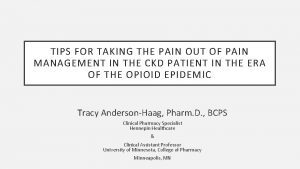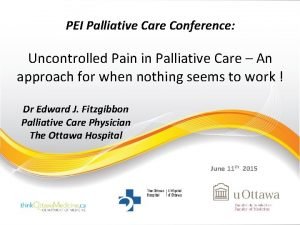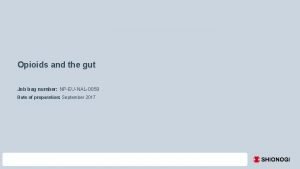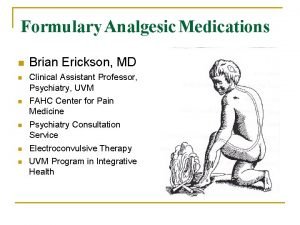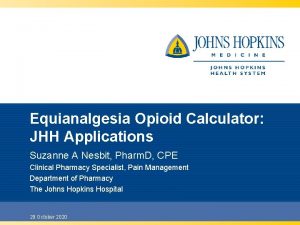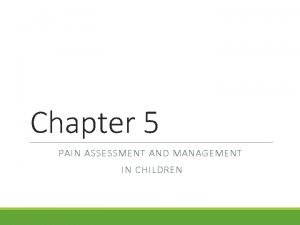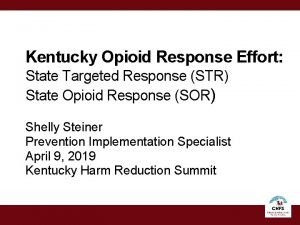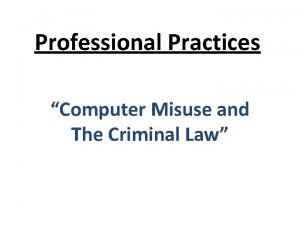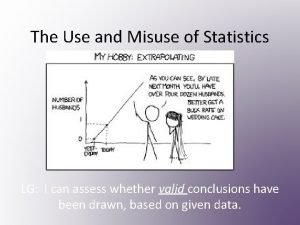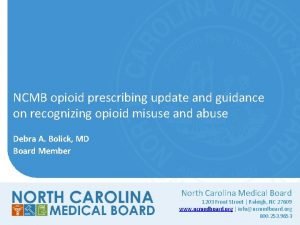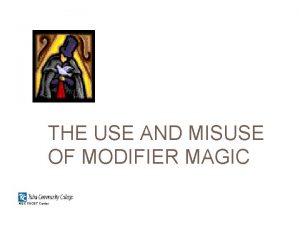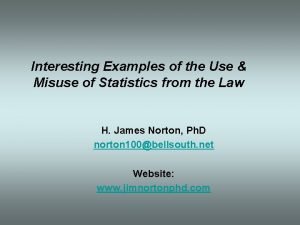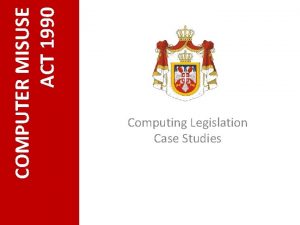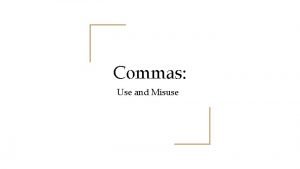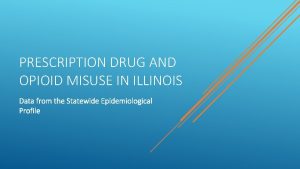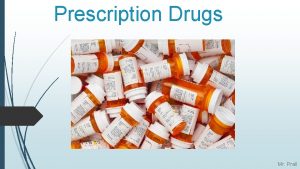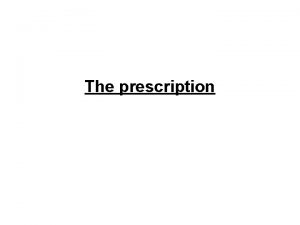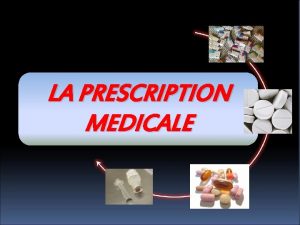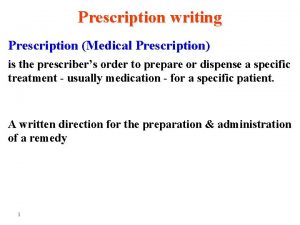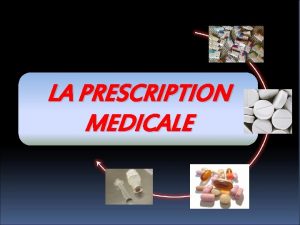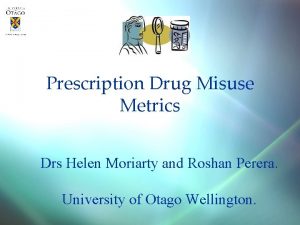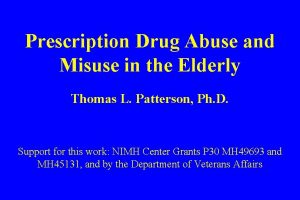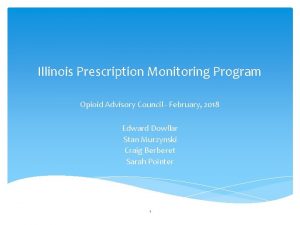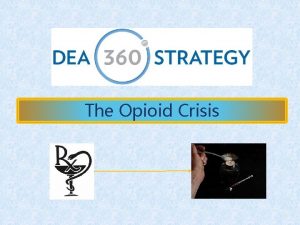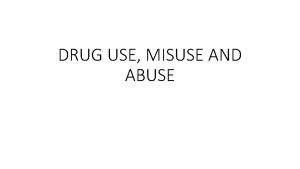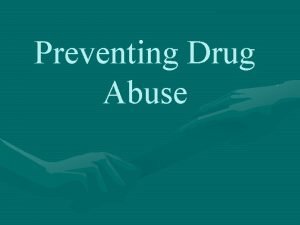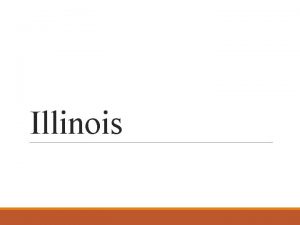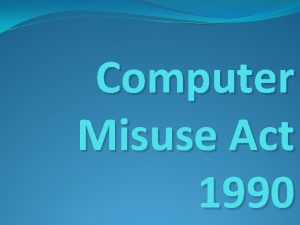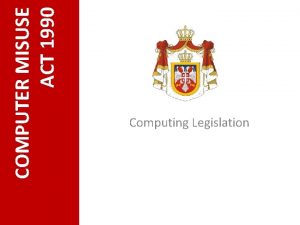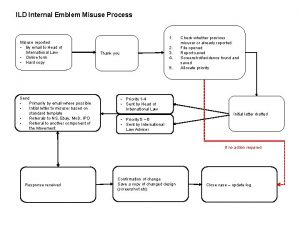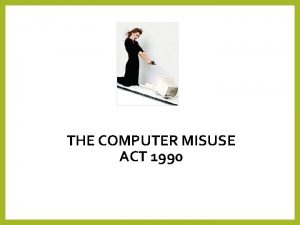PRESCRIPTION DRUG AND OPIOID MISUSE IN ILLINOIS Data




























- Slides: 28

PRESCRIPTION DRUG AND OPIOID MISUSE IN ILLINOIS Data from the Statewide Epidemiological Profile

STATEWIDE EPIDEMIOLOGICAL PROFILE Developed by: Illinois Statewide Epidemiological Outcomes Workgroup 100% Funded by: Substance Abuse and Mental Health Services Administration through a grant administered by the Illinois Department of Human Services, Division of Alcoholism and Substance Abuse’s Strategic Prevention Framework. Partnerships for Success Published: November 2017 Posted: http: //publish. illinois. edu/cprd/files/2017/10/State_of_Illinois. Prescription. Drug. Epi demiological. Profile. pdf

EPIDEMIOLOGICAL PROFILE CONTENTS Chapters Chapter 1: Consumption and Prevalence Chapter 2: Contributing Factors (aka Risk and Protective Factors) Chapter 3: Consequences Appendices A. B. C. Data Sources Source information (i. e. , agency name, department name, etc. ) Methodology (i. e. , how the data was collected, from whom, how often, etc. ) Specific information about data collected (i. e. , ICD-10 codes for hospital information) Question Wording Specific question wording for survey data Response options for each question used References/Citations for Articles Presented in Profile

CONSUMPTION AND PREVALENCE

CONTENTS OF CONSUMPTION AND PREVALENCE Question wording for different types of drugs Prescription Painkillers “Other” prescription drugs Drugs not prescribed to you Heroin use Question wording for different timeframes of use Past 30 days Past year Lifetime use Demographics of Users Illinois vs. United States Use within the college student population

Painkillers vs. “Other” prescription drugs “To Get High” The Illinois Youth Survey separated prescription drugs into two categories: painkillers (Oxy. Contin, Vicodin, Lortab, etc. ) and other prescription drugs (Adderall, Ritalin, Xanax, etc. ). Use of these drugs for the past 30 days and the past year were asked on the survey. As you can see below, the rate of using “other prescription drugs” is higher than “prescription painkillers” for use during the past year.

Prescription Drugs “Not prescribed to you” The Illinois Youth Survey also asked about using prescription drugs that were “not prescribed to you” during the past 30 days and past year. This is a core measure for the Drug Free Communities grant. Below you can see the rates of past 30 day use and past year use across 2 survey administrations by grade for 8 th, 10 th, and 12 th grade high school students.

Heroin Use Some research suggests that there may be a link between early nonmedical use of opioid pain relievers with later heroin use (Jones, 2013). As shown in the data below across 3 IYS administrations, it appears heroin use increased slightly in 2014 for 8 th and 10 th grades, but remained steady for 12 th grade. Overall, heroin use appears to be quite small, making up less than 1% of youth.

Frequency of Drug Use For those using prescription drugs “not prescribed to you, ” a comparison was made between those who only used during the past year and not the past 30 days, versus those who were more frequent users (used in both the past 30 days and the past year). In the chart below, the data is presented by grade.

Demographics of Prescription Drug Users According to the data collected from the Illinois Youth Survey, those who reported using prescription drugs “not prescribed to you” were more likely to be: Male White/Caucasian or Latino Low Socioeconomic Status Live in Rural Areas Use more than one type of drug (Poly-Drug Use) Misuse of prescription drugs increases with age (peaks in mid-20 s)

Illinois Compared to National Data High school students are asked about using prescription drugs “not prescribed to you” on both the Illinois Youth Survey and the nationwide Monitoring the Future survey. This allows for comparison between youth in Illinois versus youth across the United States. Presented below is the data from both sources, which show that Illinois youth report using prescription drugs slightly less often during the past 30 days and past year.

Illinois Compared to National Data by Age Group The National Survey on Drug Use and Health collects data by state and compares it to the national data as well. For Illinois, the highest using age group is 18 -25 year olds. As you can see below, Illinois remains slightly lower than the United States for “Nonmedical Use of Pain Relievers. ”

College Student Use by Drug Type The CORE survey in Illinois asks about types of prescription drugs used by college students. Within the past year, students reported using the following drug types seen below “without a prescription or other than prescribed. ” It appears the most common type of drug was stimulants, followed by pain medications.

CONTRIBUTING FACTORS

Perceived Peer Use in College Students The CORE Survey in Illinois also asked college students about how many students they perceived used various drug types within the past year on their campus. These results are presented below on the left, and the actual reported use is presented on the right. As you can see, the perception of peer use is higher than reported use for all drug types.

Disapproval of Use Among Middle & High School Youth The Illinois Youth Survey asks high school youth about disapproval of drug use in 3 questions. 1) How wrong do you feel it would be for you to use prescription drugs not prescribed to you? 2) How wrong do your friends feel it would be for you to use prescription drugs not prescribed to you? 3) How wrong do your parents feel it would be for you to use prescription drugs not prescribed to you? The percentage of students who responded “Wrong” or “Very wrong” are presented below for 2016 by grade. Overall, a majority of students disapprove of use. 8 th Grade 10 th Grade 12 th Grade Personal Disapproval 94. 1% 88. 7% 86. 9% Perceived Peer Disapproval 89. 1% 80. 1% 74. 1% Perceived Parent Disapproval 96. 9% 96. 7% 95. 5%

Sources of Drug Access by Middle & High School Youth The Illinois Youth Survey asked students in 8 th, 10 th, and 12 th grades if they got prescription drugs from various sources. The data presented below shows the various sources that were reported by youth who also reported using prescription drugs (“among users”). For 8 th grade, parents were the primary source. In 10 th and 12 th grades, however, youth were more likely to get them from someone other than their parents or to buy them from someone.

Sources of Drug Access by College Students The CORE Survey in Illinois also collected data on the sources of access for college students. This included information by drug type and various choices specific to prescription drugs (i. e. , fake or forged prescription). Below is a table that shows where students who reported using each type of drug said they got access to it. As you can see, the majority of drugs were accessed through a legitimate prescription or friends.

Depression and Suicidality Among Middle & High School Users The Illinois Youth Survey and Youth Risk Behavior Survey include questions related to depression and suicidality in high school youth. This data was compared between those who reported misuse of prescription drugs and those who did not. As you can see below, prescription drug users were more likely to report feeling sad and hopeless than non-users. In addition, prescription drug users were also more likely to have attempted suicide.

CONSEQUENCES

Drug Treatment Admissions by Primary Substance The Treatment Episode Data Set (TEDS) through the Substance Abuse and Mental Health Services Administration (SAMHSA) reports drug treatment admissions by primary substance at admission. One the right is a pie chart of the percent of people admitted to treatment by all of the primary substances that are tracked. Heroin and “Other Opiates” make up 30% of treatment admissions.

Drug Treatment Admissions by Age The TEDS dataset also provides information about the demographics of people admitted to drug treatment facilities. Below, you can see the age of admission over a 3 year time period with a primary substance of “other opiates. ” This data supports the data presented earlier that suggest this problem peaks in the mid-20 s.

EMS Reports of Naloxone Use Emergency Medical Service (EMS) providers can use Naloxone to reverse the effects of an opioid overdose. In the state of Illinois, EMS providers around the state report the number of instances and doses of Naloxone that have been administered. Below is a map of the number of instances that one or more doses of Naloxone were given to a patient by county for the year 2015.

Emergency Dept. Visits for Prescription Drug Poisoning Emergency department visit data were compiled using ICD-10 codes and converted to a rate per 10, 000 for each county. Below is a map that outlines where the highest rates of emergency department visits for pharmaceutical poisonings occurred. The greatest rates are all with the bottom half of the state, reflecting the large number of rural counties and communities.

Opioid Overdose Deaths Data on the number of opioid overdose deaths were compiled using ICD-10 codes and converted to a rate per 10, 000 for each county. Below is a map that outlines where the highest rates of opioid overdose deaths occurred. Once again, the highest rates were all within the bottom half of the state, reflecting the large number of rural counties and communities.

Opioid Overdose Deaths in Illinois vs. United States Each year, prescription opioid overdose deaths are tracked through the CDC. Over a 4 year time period from 2012 through 2015, the rate of overdose deaths increased across the United States. In the chart below, the rates for Illinois and the United States are shown. While Illinois remained lower than the United States, the rates nearly doubled during this time period.

Overdose Deaths by Type of Opioid Overdose deaths have also been tracked by the type of the opioid a person overdosed on from 2010 -2015. Presented below are the results for Illinois. As you can see, the rate of overdose deaths has increased for synthetic opioids and heroin. Heroin-related overdose deaths increased at an especially alarming rate.

Final Notes about the Data Presented The data presented is explained in more depth and more data is provided in the full version of the epidemiological profile at: http: //publish. illinois. edu/cprd/files/2017/10/State_of_Illinois. Prescription. Dru g. Epidemiological. Profile. pdf Questions about this data can be directed to: The Center for Prevention Research and Development The University of Illinois at Urbana-Champaign 510 Devonshire Drive Champaign, IL 61820 217 -333 -3231
 Ilpmp org
Ilpmp org Ac iv medical abbreviation
Ac iv medical abbreviation Alabama prescription drug monitoring program
Alabama prescription drug monitoring program Texaspmp
Texaspmp Example of crude drug adulterated with exhausted drug
Example of crude drug adulterated with exhausted drug Poss sedation scale
Poss sedation scale Opioid analjezikler
Opioid analjezikler Herzreizleitungsstörung
Herzreizleitungsstörung Opioid overdose
Opioid overdose Opioid overdose
Opioid overdose Opioid overdose
Opioid overdose Types of pain
Types of pain Mechanism of action of opioid analgesics
Mechanism of action of opioid analgesics Elisha peterson md
Elisha peterson md Opioid receptors location
Opioid receptors location Brian erickson md
Brian erickson md Suzanne nesbit
Suzanne nesbit Non-opioid
Non-opioid Kentucky opioid response effort
Kentucky opioid response effort How to prevent computer misuse act
How to prevent computer misuse act Use and misuse of statistics
Use and misuse of statistics Nccsrs
Nccsrs Modifier in a sentence
Modifier in a sentence Misuse of statistics examples
Misuse of statistics examples Card stacking ads
Card stacking ads Ocr computer science checklist
Ocr computer science checklist Misuse of statistics examples
Misuse of statistics examples Computer misuse act cases
Computer misuse act cases Comma misuse
Comma misuse
